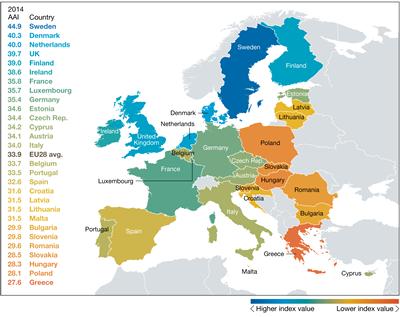Active ageing on the up in EU, despite economic crisis and austerity
A healthy and active old age is a reality for many Europeans and is a genuine possibility for many more, despite the 2008 economic crash and years of austerity measures, according to a new United Nations Economic Commission for Europe (UNECE) and European Commission (EC) report, produced at the University of Southampton.

However, countries such as Greece and Latvia have declined in active ageing capacity during the four years from 2008 to 2012.
The Active Ageing Index (AAI) Analytical Report is being presented today (Thursday 16 April) at a UNECE/EC conference in Brussels. It details the extent to which 28 European Union nations are facilitating the potential of older people to contribute not just to their own wellbeing, but also to help sustain greater economic and social prosperity for society as a whole.
Professor Asghar Zaidi, who is the lead author of the report and who is presenting its findings at the UNECE/EC AAI International Seminar, says: “Active ageing means growing older in good health and as a full member of society, feeling more fulfilled in jobs and also in social engagements, more independent in our daily lives and more engaged as citizens. But this can’t happen without changes in our own lifestyles as well as help from governments and relevant agencies.”
The report provides detailed analysis of what progress has been made in active ageing from 2008 to 2012 across the EU member states. On average, there was an increase of nearly two points in the EU overall, while an increase of nearly three points or more is observed in nine countries.
These latest results show that countries at the top of the AAI score (Sweden, Denmark, the Netherlands and the UK) have done consistently well across all four areas of active ageing: employment, social participation, independent living and capacity of active ageing.
“This indicates that active ageing is a coherent policy area where a balanced and well-founded approach can lead to achievements that leave nobody behind,” says Professor Zaidi. “At the same time, no country scores consistently at the very top in each indicator of active ageing, indicating that there is progress to be made for everyone but in different dimensions.”
Affluent EU Member States in the Nordic region and Western Europe have had greater success in sustaining employment and providing income security and achieving an active, engaged older population.
Lower income EU Member States have faced greater challenges, but some have still achieved employment scores above the EU-28 average. Although the global financial crisis has damaged employment levels, especially for younger people, policies to counter early retirement including raising the age of retirement, were not reversed during this period. As such, overall older people were more protected from the adverse impact of the economic downturn than the younger people.
By benchmarking country performances, the data included in the report encourages governments to look at policies and programmes that other countries have adopted and learn from those experiences. For example, Denmark and the UK are tenth and seventh in the ranking for social participation. Understanding why Ireland and Italy have much higher scores in this respect will help to shape policies to foster more participation in Denmark and the UK.
The separate analysis for men and women confirms that scores for men are higher, especially where employment and incomes are involved. Employment differences reflect a number of factors and the report predicts that it will take time to narrow, as the more equal labour market experiences of younger women begin to show up in cohorts approaching retirement.
Professor Zaidi says: “Overall, it is safe to assume that some progress has been made with regard to active ageing over this period, and further progress can be expected once economic and budgetary conditions have returned to normal. It is unclear though how much of the progress observed is attributable to policy changes and how much is the result of past policy choices. Additional analysis will be necessary to draw further policy insights from these results.”
To download the report click on the image.
